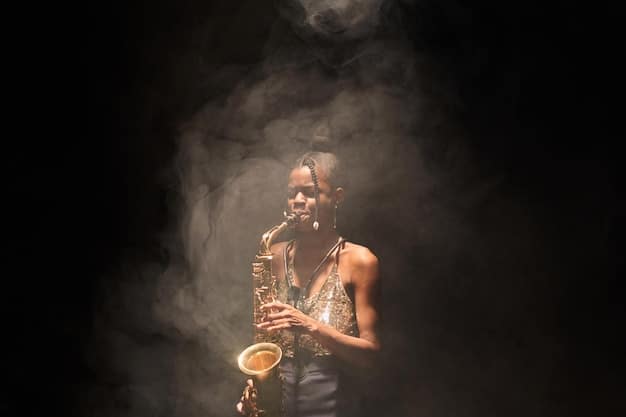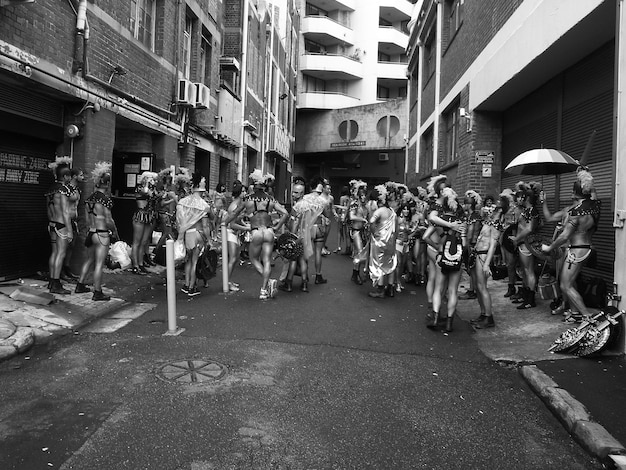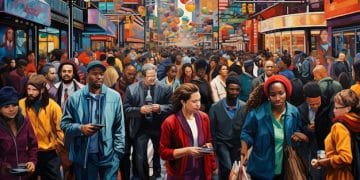Jazz to Hip-Hop: Black Music’s Cultural Evolution

Advertisements
From the spirituals of enslaved people to the global phenomenon of hip-hop, Black music in American culture has continuously evolved, profoundly influencing social discourse, artistic expression, and popular trends while serving as a powerful voice for identity and resistance.
The journey of Black music in America is a compelling narrative, a vibrant tapestry woven with threads of resilience, innovation, and profound cultural impact. It’s a story that transcends mere entertainment, reflecting the socio-political landscape and evolving identity of a people. Exploring the trajectory From Jazz to Hip-Hop: Tracing the Evolution of Black Music in American Culture reveals not just musical shifts, but a powerful commentary on American history itself.
The Roots of a Revolution: From Spirituals to Blues
The genesis of Black music in America lies deeply embedded in the experiences of enslaved Africans. Stripped of their ancestral lands and cultures, they forged new forms of expression that would eventually influence every facet of American music. These early sounds, often born out of immense suffering, laid the foundational elements for what was to come.
Spirituals, the earliest formalized vocal music, emerged from the slave plantations. These were not just songs; they were coded messages, expressions of hope, resistance, and spiritual solace. They fused African call-and-response traditions with Christian hymns, creating a unique sound that conveyed deep emotion and communal solidarity.
The Birth of the Blues
Following the Civil War and the Emancipation Proclamation, a new genre began to take shape in the rural South: the blues. This music often reflected the harsh realities of post-slavery life, echoing themes of hardship, injustice, love, and loss. The blues was characterized by its distinctive “blue notes,” a flattened third, fifth, or seventh note, which gave it a melancholic yet expressive quality.
Key characteristics of early blues included:
- Call-and-Response: A dialogue between a singer and an instrument, or between two singers.
- Improvisation: Spontaneous melodic and rhythmic variations, a cornerstone of Black musical traditions.
- Personal Narratives: Songs often told stories of individual experiences, struggles, and triumphs.
Artists like Charley Patton, Son House, and Robert Johnson became pioneers, their raw, emotive performances laying the groundwork for rock and roll, R&B, and beyond. The blues was more than music; it was a testament to survival and an enduring artistic statement.
From these profound origins, the sounds evolved, adapting to new social contexts and technologies. The raw, unfiltered expressions of spirituals and blues would soon coalesce and give birth to a more complex and multifaceted art form, paving the way for the next great musical revolution: jazz.
Jazz: A Symphony of Freedom and Innovation
As the Great Migration brought millions of African Americans from the rural South to urban centers like New Orleans, Chicago, and New York, a new musical genre exploded onto the scene: jazz. Emerging in the early 20th century, particularly from the vibrant, multicultural melting pot of New Orleans, jazz represented a radical departure from previous forms, characterized by its improvisational nature, syncopated rhythms, and a dynamic interplay between musicians.
Jazz quickly became a symbol of modernity, rebellion, and freedom. It was a fusion of ragtime’s rhythmic complexity, the blues’ emotive depth, and the rich harmonic traditions of European classical music. This genre provided African American musicians with an unprecedented platform for artistic expression and economic opportunity, though often under segregated and challenging conditions.
New Orleans: The Cradle of Jazz
New Orleans, with its diverse cultural heritage, brass bands, and Storyville district, was the perfect incubator for jazz. Musicians like Buddy Bolden, Jelly Roll Morton, and King Oliver experimented with collective improvisation, where multiple instruments dialogued simultaneously, creating a rich, layered sound. This early style, known as Dixieland or Traditional Jazz, emphasized brass and woodwind instruments.
The development of jazz led to several distinct periods:
- Swing Era (1930s-1940s): Led by big bands and bandleaders like Duke Ellington, Count Basie, and Benny Goodman, swing was immensely popular, characterized by its danceable rhythms and sophisticated arrangements.
- Bebop (1940s-1950s): A more complex and abstract form, bebop emerged as a reaction against the commercialism of swing. Pioneers like Charlie Parker and Dizzy Gillespie emphasized fast tempos, intricate harmonies, and virtuosic solos, pushing the boundaries of musicality.
- Cool Jazz and Hard Bop (1950s-1960s): Cool jazz offered a more subdued, laid-back approach, while hard bop brought back the fiery, blues-infused energy, often incorporating elements of gospel.
Jazz’s innovative spirit and complex structures not only reshaped American music but also had a profound global impact, influencing classical composers, pop artists, and countless other genres. It was a testament to the boundless creativity within Black culture, capable of transforming suffering into sublime artistry.
The improvisational freedom of jazz served as a powerful metaphor for aspirations of liberation and self-expression, paving the way for further musical evolution that continued to break barriers and define new cultural movements.
R&B and Soul: The Sound of Civil Rights
As jazz continued to evolve, the mid-20th century witnessed the rise of Rhythm and Blues (R&B) and Soul music, genres that would become inextricably linked with the Civil Rights Movement. R&B emerged from a fusion of blues, gospel, and jazz elements, offering a more commercial and uptempo sound that resonated with a broader audience. Soul, a direct descendant of R&B, added a deeper spiritual and emotive layer, often drawing heavily from gospel vocal techniques and themes.
R&B, initially labeled “race music,” transitioned into mainstream American culture, thanks to pioneers like Louis Jordan and Big Joe Turner. It was characterized by strong rhythms, often featuring electric guitars, bass, drums, and saxophone solos. This sound was crucial in bridging the gap between Black and white audiences, setting the stage for rock and roll.

The Emergence of Soul Music
By the late 1950s and early 1960s, R&B began to evolve into soul music. Soul injected more spiritual fervor, raw emotion, and direct narrative into its songs, often mirroring the aspirations and struggles of the Civil Rights era. Artists like Sam Cooke, Ray Charles, and James Brown were instrumental in shaping this new sound.
Soul music became the soundtrack of the Civil Rights Movement, its powerful lyrics and passionate performances expressing both the pain of oppression and the hope for equality. Labels like Motown Records in Detroit and Stax Records in Memphis became epicenters of soul music, each developing its distinct sound.
Notable figures and their impact on Soul:
- Aretha Franklin: The “Queen of Soul,” her powerful voice and gospel-infused delivery made anthems of songs like “Respect.”
- Marvin Gaye: Transitioned from romantic soul to socially conscious music with albums like “What’s Going On,” addressing war, poverty, and environmental issues.
- James Brown: The “Godfather of Soul,” his energetic performances and innovative rhythms laid the groundwork for funk.
These artists transformed the popular music landscape, using their platforms to challenge racial segregation and inspire social change. Soul music’s authenticity and emotional depth resonated across racial lines, making it a powerful force for unity and understanding. Its legacy continues to influence contemporary music, demonstrating the enduring power of music as a vehicle for social commentary and human connection.
The sounds of R&B and Soul were more than just melodies; they were the heartbeat of a movement, providing strength, solace, and a voice for millions seeking justice and equality in America.
Funk and Disco: Rhythmic Exploration and Dance Floor Liberation
The late 1960s and 1970s saw another significant evolution in Black music with the rise of Funk and Disco. These genres emerged from the foundations of R&B and Soul, pushing rhythmic boundaries and emphasizing grooves that encouraged communal dancing and celebration. Funk stripped down the melodic complexity of Motown-era soul, focusing intensely on bass lines and drum patterns, creating a raw, primal, and irresistibly danceable sound.
Funk, pioneered by innovators like James Brown, George Clinton (Parliament-Funkadelic), and Sly Stone, prioritized rhythm over melody. The “funk beat” became characterized by a heavy, syncopated groove, often with bass and guitar playing interlocking, percussive patterns. This emphasis on the rhythmic foundation made funk incredibly influential, directly inspiring hip-hop and house music.
Key elements of funk’s appeal included:
- Emphasis on the one: The downbeat, often accentuated by a collective instrumental punch.
- Interlocking Rhythms: Each instrument played a distinct, repetitive pattern that fit together like a complex puzzle.
- Call-and-Response: Often evident in horn sections or between vocalists and instruments.
Funk’s vibrant energy provided an escape and a celebration of Black identity during a period of ongoing social and political upheaval. It was about raw power and self-expression, a musical form designed to make bodies move.
The Rise of Disco
Emerging in the early 1970s, particularly in underground clubs in New York City, disco shared funk’s emphasis on danceability but incorporated more orchestral elements, elaborate arrangements, and a smoother, more polished sound. Disco culture became a sanctuary for marginalized communities – Black, Latino, and LGBTQ+ individuals – offering a space for liberation and self-expression away from mainstream judgment.
While often criticized for its perceived commercialism or superficiality, disco played a crucial role in promoting inclusivity and diversifying popular music. Artists like Donna Summer, the Bee Gees (who incorporated significant R&B influences), and Earth, Wind & Fire created iconic tracks that filled dance floors worldwide. Disco’s regular four-on-the-floor beat and often optimistic, escapist themes resonated with a generation seeking joy and release.
Both funk and disco, despite their differences, were crucial transitional genres. They further solidified the importance of rhythm and groove in popular music and paved the way for sampling and electronic music, setting the stage for the global phenomenon of hip-hop.
These movements showcased the dynamic adaptability and inventive spirit of Black musicians, who continued to reinterpret and redefine popular soundscapes, moving from the jazz clubs to the dance floors, shaping the future of global music.
Hip-Hop: The Global Voice of a Generation
The late 1970s in the Bronx, New York City, saw the birth of hip-hop, a cultural movement that would revolutionize music, fashion, language, and art worldwide. Emerging from block parties and community gatherings, hip-hop was initially an outlet for expression for inner-city youth, providing a platform for storytelling, social commentary, and artistic innovation. Its core elements—DJing, MCing (rapping), b-boying (breakdancing), and graffiti art—created a holistic cultural phenomenon.
At its musical core, hip-hop revolutionized sound by transforming existing records through DJing. Pioneers like DJ Kool Herc, Grandmaster Flash, and Afrika Bambaataa isolated and extended “breaks” from funk, soul, and disco records, creating continuous rhythmic loops that MCs would rhyme over. This technique, known as sampling, was a groundbreaking innovation, allowing artists to collage sounds and create entirely new sonic landscapes.
The Evolution of Rap as a Lyrical Art Form
As MCing evolved into rapping, the lyrical component of hip-hop became increasingly sophisticated. Early rap focused on party anthems and boastful rhymes, but quickly broadened its scope to address social issues, economic inequality, and the realities of urban life. Groups like Grandmaster Flash and the Furious Five (“The Message”) demonstrated the power of rap as a tool for social commentary, laying the groundwork for conscious hip-hop.
Key lyrical themes and styles:
- Social Commentary: Addressing issues like crime, poverty, and racial injustice.
- Storytelling: Vivid narratives of personal experiences or fictional tales.
- Battle Rapping: Competitive verbal sparring, showcasing lyrical prowess and wit.
The 1980s saw hip-hop gain mainstream attention, with artists like Run-DMC, LL Cool J, and the Beastie Boys breaking down barriers. The 1990s brought forth diverse subgenres, from the conscious rhymes of A Tribe Called Quest to the gangsta rap of N.W.A., which provocatively portrayed the realities of street life, sparking both controversy and critical acclaim.

Hip-hop’s global reach is undeniable. It has become the most dominant musical genre in many parts of the world, influencing pop, rock, and electronic music. Its entrepreneurial spirit, innovative production techniques, and lyrical depth continue to push artistic boundaries, solidifying its place not merely as a genre, but as a central pillar of global popular culture.
From its humble beginnings in the Bronx to its current status as a global phenomenon, hip-hop stands as a powerful testament to the constant evolution and enduring influence of Black music in American culture, consistently reflecting and shaping societal narratives.
The Cultural and Socio-Political Impact of Black Music
Beyond its melodic and rhythmic innovations, Black music, from jazz to hip-hop, has served as a powerful mirror reflecting and influencing the ever-changing socio-political landscape of America. It has been a constant voice for expression, resistance, and identity for African Americans, often ahead of mainstream society in addressing critical issues and breaking down racial barriers.
In the early 20th century, spirituals provided solace and coded messages of resistance during slavery, while the blues voiced the post-emancipation struggles and the complexities of Black life in the rural South. Jazz, with its improvisational freedom, became a metaphor for defying conformity and a vibrant representation of Black creativity in the face of segregation. It opened doors for Black artists to perform in new venues and gain international recognition, albeit within a deeply discriminatory society.
Music as a Catalyst for Change
The mid-20th century saw Rhythm & Blues and Soul music become the undeniable soundtrack to the Civil Rights Movement. Songs like Sam Cooke’s “A Change Is Gonna Come” and Nina Simone’s “Mississippi Goddam” were not just popular tunes; they were anthems of hope, defiance, and a call for justice. These songs articulated the collective consciousness of a people fighting for equality, mobilizing and inspiring millions.
The Civil Rights Movement itself was profoundly intertwined with these musical genres:
- Unifying Force: Music brought people together, fostering a sense of community and shared purpose.
- Expressing Grievances: Lyrics directly addressed racial injustice, police brutality, and segregation.
- Inspiring Hope: Many songs offered messages of resilience and the promise of a better future.
As the decades progressed, funk continued to celebrate Black identity and self-empowerment, while disco provided a space for liberation for marginalized communities, including Black LGBTQ+ individuals. However, it was hip-hop that took the mantle of direct socio-political commentary to unprecedented levels. Early hip-hop tracks vividly depicted urban decay, systemic racism, and the struggles of inner-city life, often sparking national dialogue and controversy.
From Public Enemy’s revolutionary rhetoric to Kendrick Lamar’s intricate narratives on racial identity and police brutality, hip-hop has consistently provided a raw and unfiltered perspective on American society. It amplified voices from disenfranchised communities, offering critiques of power structures and advocating for social change.
The cultural impact of Black music extends globally, transcending borders and influencing diverse musical traditions worldwide. It has shaped fashion, language, dance, and intellectual discourse, demonstrating its profound and sustained influence on American culture and beyond.
The continuous evolution of Black music underscores its role not just as entertainment, but as a vital historical record, a cultural force, and a powerful agent of social change, constantly pushing boundaries and redefining norms.
Beyond the Genres: Legacy and Future Directions
The remarkable journey from jazz’s complex improvisations to hip-hop’s global lyrical dominance is far from over. Black music continues to evolve, innovate, and influence popular culture around the world. Its legacy is deeply entrenched in the fabric of American society, shaping not only music but also fashion, language, social movements, and global trends.
The foundational elements established by earlier genres—such as improvisation from jazz, the emotive storytelling of blues and soul, the rhythmic intensity of funk, and the sampling ingenuity of hip-hop—continue to serve as building blocks for new artists across all genres. Contemporary pop, R&B, electronic music, and even country music often bear traces of these earlier Black musical innovations, whether consciously or unconsciously.
The Continuing Influence and Adaptation
Today, artists are constantly blurring genre lines, creating fusion sounds that reflect an increasingly interconnected world. Neo-soul blends R&B, jazz, and hip-hop. Afrobeats, originating from West Africa but heavily influenced by global Black music forms, has become a global phenomenon. Trap music, a subgenre of hip-hop, demonstrates how regional sounds can achieve international resonance. These new forms underscore the dynamic and adaptive nature of Black music.
Furthermore, technology continues to play a significant role in this evolution. Digital audio workstations, online streaming platforms, and social media allow artists to create, distribute, and connect with audiences in unprecedented ways, fostering new communities and accelerating musical trends. The democratization of music production tools means that the spirit of innovation, once confined to studios or live performances, is now accessible to a wider array of creators.
Consider the myriad ways Black music’s influence is seen:
- Fashion: From zoot suits of the jazz era to baggy clothes of hip-hop, trends often originate from Black music subcultures.
- Language: Slang and expressions coined within Black musical contexts frequently permeate mainstream vocabulary.
- Activism: Music remains a potent tool for social justice, connecting with a long lineage of protest songs.
The narrative of Black music in America is one of constant negotiation—between tradition and innovation, protest and celebration, isolation and global reach. It is a testament to the enduring power of creativity and resilience in the face of adversity. The future promises even more diverse and transformative sounds, as new generations of artists continue to build upon this rich and powerful legacy.
Thus, from the profound depths of its origins to its vibrant contemporary forms, Black music in American culture stands as a testament to artistic evolution, cultural leadership, and an unstoppable force of progress and expression.
| Key Stage | Brief Description |
|---|---|
| 🎶 Roots: Spirituals & Blues | Founded on resilience and raw emotion, expressing identity and hardship. |
| 🎺 Jazz: Innovation & Freedom | Improvisational soundscapes reflecting post-slavery aspirations. |
| 🎤 R&B/Soul: Voice of Civil Rights | Emotive anthems and powerful narratives driving social change. |
| 🎧 Hip-Hop: Global Phenomenon | Lyrical artistry and sampling mastery reflecting urban realities and global influence. |
Frequently Asked Questions About Black Music’s Evolution
The earliest forms of Black music in America were primarily spirituals and work songs, originating from enslaved Africans. Spirituals combined African musical traditions with Christian hymns, often carrying coded messages of hope and resistance, while work songs synchronized labor and provided emotional release. These forms laid the rhythmic and melodic groundwork for subsequent genres like the blues.
Jazz profoundly influenced American culture by introducing new forms of improvisation, syncopated rhythms, and a spontaneous, free-spirited approach to music. It became a symbol of modernity and rebellion, breaking down social barriers by attracting diverse audiences to clubs and dance halls, and promoting Black artists to international recognition. Jazz also significantly impacted fashion, dance, and intellectual discourse of its era.
Soul music served as a powerful soundtrack and unifier for the Civil Rights Movement. Its emotive lyrics and gospel-infused vocals expressed the struggles, aspirations, and resilience of African Americans. Artists like Aretha Franklin and Sam Cooke used their platforms to advocate for equality, with their songs becoming anthems of protest and hope, inspiring millions to join the fight for social justice and racial equality.
Hip-hop revolutionized music production through innovative DJing and sampling techniques, creating new tracks from existing records. Lyrically, it provided a raw and unfiltered voice for urban youth, moving from party rhymes to complex storytelling and poignant social commentary on issues like poverty, systemic racism, and violence. This transformation made hip-hop a powerful medium for reflecting and critiquing societal realities.
Black music continues to shape contemporary culture across various facets. Its rhythmic and melodic structures are evident in modern pop, R&B, and electronic genres. Beyond music, it influences global fashion trends, informs linguistic expressions, and remains a potent tool for social and political activism. The constant innovation and adaptability of Black music ensure its enduring impact on all forms of artistic expression and cultural discourse.
Conclusion
The sprawling narrative of Black music in American culture, from its ancestral roots in spirituals to the pervasive global influence of hip-hop, is a testament to extraordinary resilience, unwavering creativity, and profound cultural impact. Each genre, born from a specific social and historical context, not only pushed the boundaries of musical expression but also served as a vital voice for a people navigating change, struggle, and eventual triumph. This evolution reflects more than just shifts in tastes; it embodies a continuous wellspring of innovation that has undeniably shaped American identity and resonates profoundly across the world.





